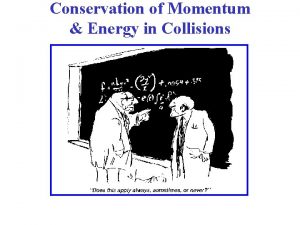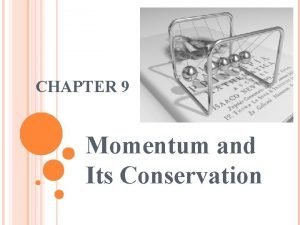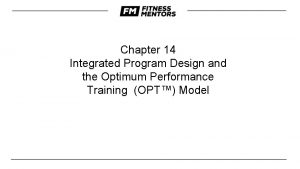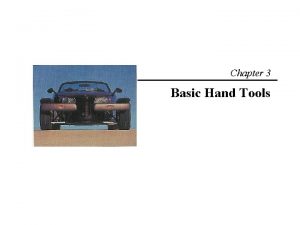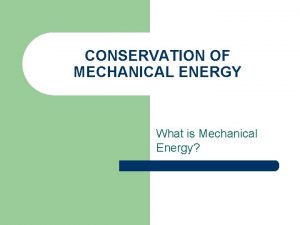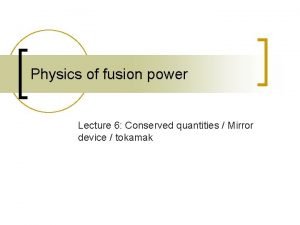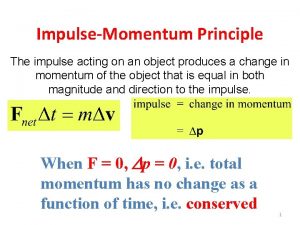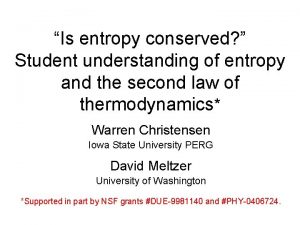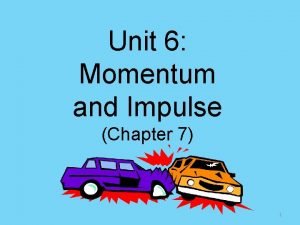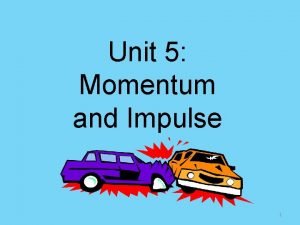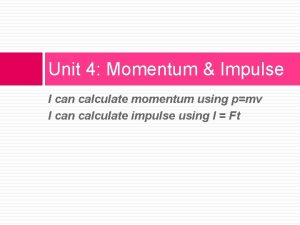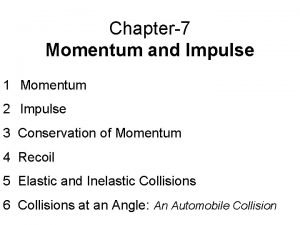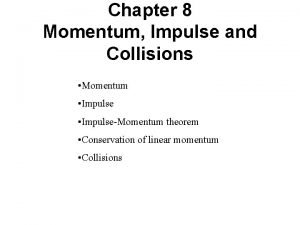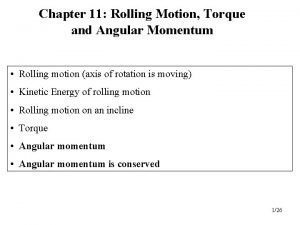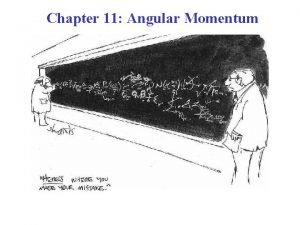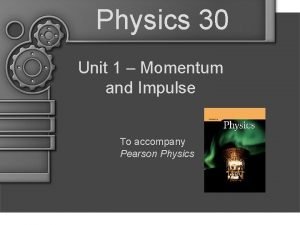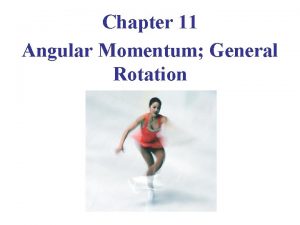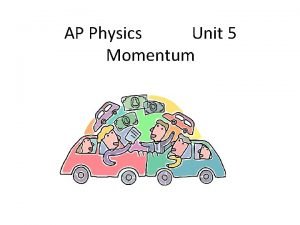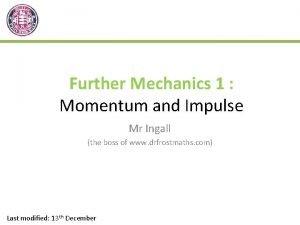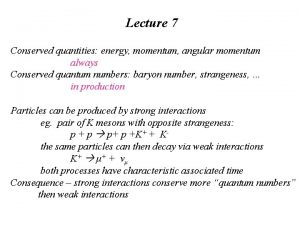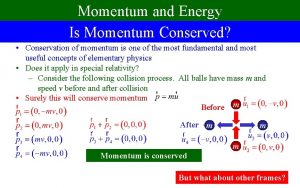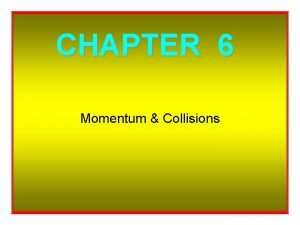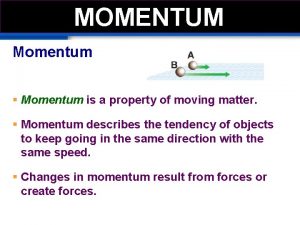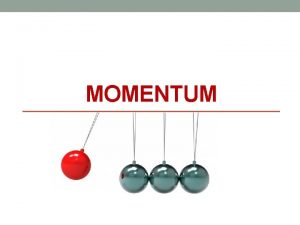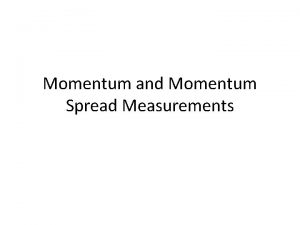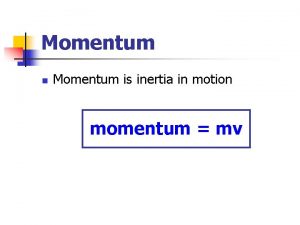Unit 4 Momentum Chp 7 Momentum is conserved







































- Slides: 39

Unit 4: Momentum (Chp 7) Momentum is conserved for all collisions.

7. 1 Momentum It is harder to stop a large truck than a small car when both are moving at the same speed. The truck has more momentum than the car. Momentum: inertia in motion momentum = mass × velocity p = mv

7. 1 Momentum • A truck at rest has no momentum at all. p = mv p = m(0) = 0

7. 1 Momentum • A truck at rest has no momentum at all. • A moving truck has more momentum than a moving car at the same speed because the truck has more mass. p = mv truck p = mv car p = mv

7. 1 Momentum • A truck at rest has no momentum at all. • A moving truck has more momentum than a moving car at the same speed because the truck has more mass. • A fast car can have the same or more momentum than a slow truck. p = mv slow truck p = mv fast car p m = v

7. 1 Momentum If both move at the same speed, which has more p? truck How can the skate get more p than the truck? more velocity

Quick Quiz! 1. When the speed of an object is doubled, its momentum… A. stays the same because mass is the same. B. doubles. C. quadruples. D. halves.

Quick Quiz. 2. What is the momentum of a 1200 kg car moving at 30 m/s? A. 40 kg-m/s B. 400 kg-m/s C. 3600 kg-m/s D. 36, 000 kg-m/s p = mv p = (1200)(30) p = 36, 000 kg-m/s

Quick Quiz. 3. What is the velocity of a 1000 kg car with the same momentum as a 1500 kg truck moving at 20 m/s? A. 30, 000 m/s p = mv B. 1000 m/s ptruck = (1500)(20) C. 30 m/s ptruck = 30, 000 kg-m/s D. 20 m/s 30, 000 = (1000) x vcar = (30, 000)/(1000) vcar = 30 m/s

7. 2 Impulse Changes Momentum For the momentum of an object to change, either the mass or the velocity or both change. The greater the force acting on an object, the greater its change in velocity and the greater its change in momentum.

7. 2 Impulse Changes Momentum Impulse Both force and time are important in changing an object’s momentum. A force applied for a long time produces more change in momentum than when applied briefly. Push with the same force for twice the time, you impart twice the impulse (twice the change in momentum).

7. 2 Impulse Changes Momentum Impulse: force × time interval impulse = F × t The greater the impulse exerted on something, the greater will be the change in momentum. impulse = change in momentum Ft = ∆mv

7. 2 Impulse Changes Momentum Ft = ∆mv To increase momentum, apply the greatest force possible for as much time as possible. (swing hard AND follow through) more F more t in contact more impulse or ∆mv

7. 2 Impulse Changes Momentum If you were in a car that was out of control and had to choose between hitting a haystack or a concrete wall, which would you choose? Haystack!! Physics helps you to understand why hitting a soft object is entirely different from hitting a hard one.

7. 2 Impulse Changes Momentum If the change in momentum (∆mv) occurs over a long time (t), the average force of impact (F) is small. F t Ft = ∆mv If the change in momentum (∆mv) occurs over a short time (t), the average force of impact (F) is large. = ∆mv = F t

7. 2 Impulse Changes Momentum When you extend the time, you reduce the average force. • Airbags save lives. • Egg toss or bare-handed baseball catch. • When you jump down to the ground, bend your knees when your feet make contact with the ground to extend the time during which your momentum decreases. • A wrestler thrown to the floor extends his time of hitting the mat, spreading the impulse into a series of smaller ones as his foot, knee, hip, ribs, and shoulder successively hit the mat.

7. 2 Impulse Changes Momentum The impulse provided by a boxer’s jaw counteracts the momentum of the punch. a. The boxer moves away from the punch.

7. 2 Impulse Changes Momentum The impulse provided by a boxer’s jaw counteracts the momentum of the punch. a. The boxer moves away from the punch. b. The boxer moves toward the punch. Ouch!

7. 2 Impulse Changes Momentum think! Why is a glass dish more likely to survive if it is dropped on a carpet rather than a sidewalk? The carpet has more “give. ” Since time is longer hitting the carpet than hitting the sidewalk, a smaller average force results. The shorter time hitting the sidewalk results in a greater average stopping force.

7. 2 Impulse Changes Momentum think! So when a dish falls, is the impulse less if it lands on carpet or if it lands on a hard floor? The impulse would be the same for either surface because the same momentum change occurs for each (same ∆mv). The F or t can be bigger or smaller as long as they equal the same ∆mv. F t = ∆(mv) = F t

7. 2 Impulse Changes Momentum think! If a boxer is able to make the contact time twice as long by “rolling” with the punch, how much will the force of the punch impact be reduced? Since the time of impact increases two times, the average force of impact will be reduced two times (or halved) F t

7. 3 Bouncing If a flower pot falls from a shelf and breaks on your head, it will hurt. If it bounces from your head, it will be hurt more because impulses are greater when an object bounces. WHY? The impulse (∆mv) is greater b/c as the pot bounces it stops on your head (∆mv) and then is knocked back up again (∆mv). Bouncing doubles the impulse b/c 2 changes in momentum.

7. 3 Bouncing She imparts a large impulse to the bricks in a short time and produces considerable force. Her hand bounces back, yielding as much as twice the impulse to the bricks.

Quick Quiz! 1. The impulse-momentum relationship is a direct result of Newton’s… A. first law. Ft = ∆mv B. second law. C. third law. F = m∆v D. law of gravity. F = ma More mass, more momentum, more force needed to change it (or more time needed).

Quick Quiz. 2. When a falling object bounces, as it hits the ground its change in momentum and the impulse on it is… A. less than for stopping. WHY? B. greater than for stopping. C. the same as it is for stopping. D. the same as it was when dropped.

7. 4 Conservation of Momentum The p before firing is zero. After firing, the net p is still zero because the p of the cannon is equal and opposite to the p of the cannonball. p = mv = m(0) p=0 pnet = mv – mv p=0 mv m v

7. 4 Conservation of Momentum When any quantity in physics does not change, we say it is conserved. Law of Conservation of Momentum: The net momentum of a system before and after an event is the same. The collision of objects clearly shows the conservation of momentum. net pbefore = net pafter

7. 5 Collisions Elastic Collision: mvi + Mvi = mvf + Mvf objects bounce apart with same mass/shape with no energy lost. mv 0 = 0 Mv

7. 5 Collisions Elastic Collision: mvi + Mvi = mvf + Mvf objects bounce apart with same mass/shape with no energy lost. mv mv 0 – Mv = 0 = – mv Mv Mv

7. 5 Collisions Elastic Collision: mvi + Mvi = mvf + Mvf objects bounce apart with same mass/shape with no energy lost. mv mv mv 0 – Mv Mv = 0 = – mv = mv Mv Mv Mv

7. 5 Collisions Inelastic Collision: mvi + Mvi = (m + M)vf objects stick together, have a new velocity, and may lose energy (heat/sound). (m)(4 m/s) + (m)(0 m/s) = (2 m)(vf) 4 m + 0 = 2 mvf vf = 2 m/s 4 m / 2 m = vf

7. 5 Collisions Perfectly elastic collisions are not common in the everyday world. Drop a ball and after it bounces from the floor, both the ball and the floor are a bit warmer. At the microscopic level, however, perfectly elastic collisions are commonplace. For example: - charged particles and gas molecules bounce off one another without generating heat

7. 5 Collisions Example 1: (Inelastic) A 6 kg fish swims at 1 m/s toward a 2 kg fish at rest and swallows it. What is its velocity immediately after lunch? net pbefore = net pafter mvi + Mvi = (m + M)vf (6)(1) + (2)(0) = (6 + 2)vf 6 = 8 vf 6 = vf vf = 0. 75 m/s 8

7. 5 Collisions Example 2: (Inelastic) The 6 kg fish at 1 m/s eats another 2 kg fish swimming toward the large fish at 2 m/s. If we consider the direction of the large fish as positive, then the velocity of the small fish is – 2 m/s. mvi + Mvi (6)(1) + (2)(– 2) 6 + – 4 2 2 8 = (m + M)vf = (6 + 2)vf = 8 vf = vf vf = 0. 25 m/s

7. 5 Collisions Example 3: (Inelastic) The 6 kg fish at 1 m/s eats another 2 kg fish swimming toward the large fish at – 4 m/s. mvi + Mvi (6)(1) + (2)(– 4) 6 + – 8 – 2 8 = (m + M)vf = (6 + 2)vf = 8 vf = vf vf = – 0. 25 m/s

7. 5 Collisions Example 4: (Elastic) A 70 kg bumper car driving 8 m/s bounces off a 60 kg car at rest. If the 60 kg car moves at 5 m/s after the collision, what’s the velocity of the 70 kg car? net pbefore = net pafter mvi + Mvi = mvf + Mvf (70)(8) + (60)(0) = (70)vf + (60)(5) 560 = 70 vf + 300 – 300 260 = 70 vf 260 = vf 70 vf = 3. 7 m/s

7. 5 Collisions Example 5: (Elastic) A 70 kg bumper car driving 4 m/s bounces off a 60 kg car at – 8 m/s. If the 60 kg car moves at 2 m/s after the collision, what’s the velocity of the 70 kg car? mvi + Mvi = mvf + Mvf (70)(4) + (60)(– 8) = (70)vf + (60)(2) 280 + – 480 = 70 vf + 120 – 200 = 70 vf + 120 – 320 = 70 vf – 320 = vf 70 vf = – 4. 6 m/s

Quick Quiz! 1. A big fish swims upon and swallows a small fish at rest. After lunch, the big fish has less … A. speed. B. mass. C. momentum. D. All of the above. E. None of the above.

Quick Quiz. 2. On roller blades you horizontally toss a ball away from you. The mass of the ball is one tenth your mass. Compared with the speed you give to the ball, your recoil speed will be… A. one tenth as much. B. the same. C. ten times as much. D. 100 times as much.
 Momentum is conserved
Momentum is conserved Perfect inelastic collision
Perfect inelastic collision Conservation momentum
Conservation momentum What is conservation of momentum
What is conservation of momentum Is momentum conserved in all collisions
Is momentum conserved in all collisions Conservation of linear momentum
Conservation of linear momentum California bit program
California bit program Yenifer chp vr
Yenifer chp vr Chp
Chp Opt.model
Opt.model If thy right hand offend thee
If thy right hand offend thee Basic hand tools list
Basic hand tools list Chp mission statement
Chp mission statement Double ended queue
Double ended queue Chp 14
Chp 14 Decp
Decp Seleccion estabilizadora
Seleccion estabilizadora Chp christiansburg va
Chp christiansburg va What is the conservation of mechanical energy
What is the conservation of mechanical energy Starting from rest a child zooms down
Starting from rest a child zooms down Law of conservation of mechanical energy
Law of conservation of mechanical energy Outward power coils
Outward power coils The impulse acting on an object is equal to the
The impulse acting on an object is equal to the Total mechanical energy
Total mechanical energy Is entropy conserved
Is entropy conserved Conceptual physics chapter 6 momentum
Conceptual physics chapter 6 momentum Unit 6 review questions
Unit 6 review questions Unit 6 momentum and impulse
Unit 6 momentum and impulse Unit of momentum and impulse
Unit of momentum and impulse Momentum measurement unit
Momentum measurement unit Impulse units
Impulse units Unit for momentum
Unit for momentum Unit of momentum
Unit of momentum Impulse and momentum in sports
Impulse and momentum in sports Si unit of angular momentum
Si unit of angular momentum Angular momentum is equal to
Angular momentum is equal to Momentum and impulse physics 30
Momentum and impulse physics 30 Whats angular momentum
Whats angular momentum Impulse and momentum
Impulse and momentum Further mechanics 1 unit test 1 momentum and impulse
Further mechanics 1 unit test 1 momentum and impulse

